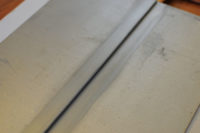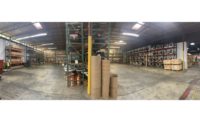Architectural sheet metal components such as flat-seam roofing and flashings must be joined properly to maintain durable and reliable watertight assemblies (Photo 1). The most common ways of making architectural sheet metal joints watertight are through the use of sealants or solder. While sealants can provide watertight integrity on steep-sloped applications, the relatively short service life of sealants when compared to the expected service life of sheet metal make them an unreliable choice for assemblies that must rely on long-term watertight integrity of the joints to prevent water intrusion. This is especially critical in low-slope applications where water may linger or pond on the surface of the sheet metal. Since most architectural sheet metal components are formed from materials of less than 1/16-inch in thickness, the joints cannot feasibly be welded and must be joined with solder.
Unlike welding, soldering involves melting a soft alloy metal that must fill the joint between and bond with the base metal to produce a strong, durable joint. Due to its relatively low melting point and intrinsic ductile nature, solder is generally weak and fails when exposed to tensile or shear stresses. Architectural sheet metal installations are often subject to widely varying temperatures in service, and the resulting thermal stresses will expose any weakness in soldered joints, and will lead to cracking or failure of the joints. To prevent stress-induced failure, soldered sheet metal joints must be mechanically strengthened with a lock-seam or rivets to prevent premature failure. Since the watertight integrity of a soldered joint is dependent on the continuity and bond of the solder within the joint of the base material, rigorous quality control measures for material selection, joint preparation and soldering techniques must be implemented to avoid failed joints that are vulnerable to water infiltration.
This article discusses the materials, preparation and construction processes necessary to reliably assemble watertight soldered sheet metal roofing and flashing components. This article also discusses other considerations for designing and inspecting soldered sheet metal joints, and provides additional resources to assist designers and installers in understanding, selecting and constructing soldered joints in sheet metal.
Materials and Tools
Soldering a particular joint in architectural sheet metal begins with the selection of materials and tools to successfully perform the work. Soldering is performed on the joint between sections of base sheet metal by using flux to clean the base metal and flowable solder to fill the joint. To successfully solder, a sheet metal mechanic must also use the appropriate tools and other miscellaneous materials when forming, cleaning and installing the joint. The following sections discuss the requirements and considerations for selecting materials and tools necessary to install reliable and durable soldered joints.
Sheet Metal Base Material
Sheet metal material selection is driven largely by aesthetics and chemical compatibility with adjacent building components. Copper, coated copper (zinc-tin or lead), stainless steel and galvanized steel can all be soldered successfully if the correct materials and techniques are used. For example, soldering stainless steel requires higher heat compared to copper due to this base material’s relatively low thermal conductivity and the higher melting point of lead-free solder that is commonly used with stainless steel. The metal’s lower thermal conductivity also requires a cooler iron to prevent severe thermal gradients within the stainless steel which can cause warping and buckling. A mechanic must use a cooler iron in good contact with the metal to transmit more heat to the work; this requires attention to good technique and patience.
[Note: Aluminum and other sheet metals can also be soldered in the factory; however the materials and technique required are significantly different from those sheet metals listed above, making field-soldering such metals impractical; therefore, they are not discussed in this article.]
Flux
Flux is used to clean the surface of the sheet metal base material and improve the wetting ability (flow) of the solder. Flux improves the wetting of the base metal by dissolving oxidation from the metal surface, permitting the solder to bond to the base metal. Flux must be brush-applied to only the surfaces of the joint where the solder bond is desired.
The three most common types are rosin-based flux, organic acid flux and inorganic acid flux. Inorganic acid flux, specifically hydrochloric acid, phosphoric acid, or zinc chloride (a.k.a. “killed acid”), are the fluxes most commonly used for architectural sheet metal. Corrosive (acid-based) fluxes require neutralization after the joint is soldered. Other than corrosion considerations, there are few concerns regarding specific flux selection from within the group of inorganic acids listed above. Zinc chloride and hydrochloric acid are commonly used as fluxes for soldering copper sheet material, while phosphoric acid based fluxes are often used for soldering stainless steel. See ASTM Standard B813 for additional information on the material standards and testing for flux.[1]
Solder
The most common solders used in architectural sheet metal applications are 50/50 or 60/40 tin/lead solder, or 95/5 tin-silver solder. Tin is the primary soldering element, and is alloyed with other metals to affect melting temperature, strength, corrosion resistance, or other properties. Solder alloys typically have a “pasty” range where the material will flow, but is still somewhat solid as well. Varying the composition of the other metals alloyed with tin alters the pasty range by changing the “liquidus” point at which the solder is fully melted. [2] The workability of a solder is closely related to its melting temperature; solders that melt at lower temperatures are more workable because they flow readily with less heat applied to the metal. Conversely, maintaining higher joint temperatures, required for some solders, can be difficult because under-heating can result in a weak and leaking joint, while overheating can cause oxidation of the base metal that affects solder bond, and/or damage to adjacent building components. Solders with a wider pasty range can be shaped as they cool, whereas eutectic solders, which solidify all at once, are difficult to shape.
Of the three solder types noted above, 50/50 tin-lead solder is the most commonly used in architectural sheet metal applications, as it is readily available and commonly accepted. 60/40 tin-lead solder is closer to the eutectic point of tin-lead alloys, and as such has a lower melting temperature and narrower pasty range. 60/40 solder is commonly selected for use with lead-coated sheet metals so that as the solder alloys with the lead coating, the resulting joint does not become lead-rich, thereby weakening the joint. 95/5 tin-silver solder is commonly selected when lead-free joints are required, has a significantly higher melting point than tin-lead solders, and is therefore more difficult to work with.
Soldering Irons
There are three types of soldering irons used for architectural sheet metal work: Soldering coppers that are heated in a propane (or occasionally charcoal) pot; copper-bit gas-fired soldering irons that use a gas-burning nozzle oriented at the back end of a heavy copper bit (Photo 2); and electric soldering irons which are rarely used for sheet metal. Regardless of the type of iron selected, the critical consideration is providing sufficient heat to the joint at all times without substantially overheating either the iron or the base metal. Large soldering irons with more mass provide a greater heat capacity than smaller irons, provide more consistent and uniform heat, and are generally best for architectural sheet metal work. Smaller irons are used for intricate detailing work, where large irons cannot be used.
In the next issue, we will discuss the procedure and quality control measures for joint preparation and soldering techniques that must be implemented to avoid soldered architectural sheet metal joints that are vulnerable to failure and water infiltration due to thermal movement.
References:
- ASTM Standard B813, 2010, “Standard Specification for Liquid and Paste Fluxes for Soldering of Copper and Copper Alloy Tube,” ASTM International, West Conshohocken, PA, 2003, DOI: 10.1520/C0033-03, www.astm.org.
- Harper, C. A. (1994). Electronic materials and processes handbook (2nd ed.). New York: McGraw-Hill.








